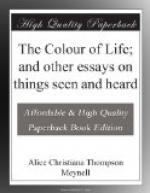The little flocks of novices, on paschal evenings, are folded to the sound of that evening prayer. The care of them is the central work of the monastery, which is placed in so remote a country because it is principally a place of studies. So much elect intellect and strength of heart withdrawn from the traffic of the world! True, the friars are not doing the task which Carlyle set mankind as a refuge from despair. These “bearded counsellors of God” keep their cells, read, study, suffer, sing, hold silence; whereas they might be “operating”—beautiful word!—upon the Stock Exchange, or painting Academy pictures, or making speeches, or reluctantly jostling other men for places. They might be among the involuntary busybodies who are living by futile tasks the need whereof is a discouraged fiction. There is absolutely no limit to the superfluous activities, to the art, to the literature, implicitly renounced by the dwellers within such walls as these. The output—again a beautiful word—of the age is lessened by this abstention. None the less hopes the stranger and pilgrim to pause and knock once again upon those monastery gates.
RUSHES AND REEDS
Taller than the grass and lower than the trees, there is another growth that feels the implicit spring. It had been more abandoned to winter than even the short grass shuddering under a wave of east wind, more than the dumb trees. For the multitudes of sedges, rushes, canes, and reeds were the appropriate lyre of the cold. On them the nimble winds played their dry music. They were part of the winter. It looked through them and spoke through them. They were spears and javelins in array to the sound of the drums of the north.
The winter takes fuller possession of these things than of those that stand solid. The sedges whistle his tune. They let the colour of his light look through—low-flying arrows and bright bayonets of winter day.
The multitudes of all reeds and rushes grow out of bounds. They belong to the margins of lands, the space between the farms and the river, beyond the pastures, and where the marsh in flower becomes perilous footing for the cattle. They are the fringe of the low lands, the sign of streams. They grow tall between you and the near horizon of flat lands. They etch their sharp lines upon the sky; and near them grow flowers of stature, including the lofty yellow lily.
Our green country is the better for the grey, soft, cloudy darkness of the sedge, and our full landscape is the better for the distinction of its points, its needles, and its resolute right lines.




